- Introduction
- Wing Geometry
- Forces in Flight
- Stability Concepts
- Stall & Spin
Stability Concepts
The aircraft's response to momentary disturbance is associated with its inherent degree of stability built in by the designer, in each of the three axes, and occurring without any reaction from the pilot.
Free flight models generally have to rely on the state of trim built in by the designer and adjusted by the rigger, while the remote controlled models have some form of trim devices which are adjustable during the flight.
An aircraft's stability is expressed in relation to each axis:
lateral stability (stability in roll),
directional stability (stability in yaw)
and longitudinal stability (stability in pitch).
Lateral and directional stability are inter-dependent.
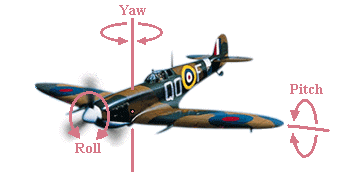
Stability may be defined as follows:
- Positive stability - tends to return to original condition after a disturbance.
- Negative stability - tends to increase the disturbance.
- Neutral stability - remains at the new condition.
- Static stability - refers to the aircraft's initial response to a disturbance.
- Dynamic stability - refers to the aircraft response over time to a disturbance.
A totally stable aircraft will return, more or less immediately, to its trimmed state without pilot intervention. However, such an aircraft is rare and not much desirable. We usually want an < aircraft just to be reasonably stable so it is easy to fly. If it is too stable, it tends to be sluggish in manoeuvring, exhibiting too slow response on the controls.
Lateral stability is achieved through dihedral, sweepback, keel effect and proper distribution of weight. The dihedral angle is the angle that each wing makes with the horizontal (see Wing Geometry). If a disturbance causes one wing to drop, the lower wing will receive more lift and the aircraft will roll back into the horizontal level.
A sweptback wing is one in which the leading edge slopes backward. When a disturbance causes an aircraft with sweepback to slip or drop a wing, the low wing presents its leading edge at an angle more perpendicular to the relative airflow. As a result, the low wing acquires more lift and rises, restoring the aircraft to its original flight attitude.
The keel effect occurs with high wing aircraft. These are laterally stable simply because the wings are attached in a high position on the fuselage, making the fuselage behave like a keel. When the aircraft is disturbed and one wing dips, the fuselage weight acts like a pendulum returning the aircraft to the horizontal level.
The tail fin determines the directional stability. If a gust of wind strikes the aircraft from the right it will be in a slip and the fin will get an angle of attack causing the aircraft to yaw until the slip is eliminated.
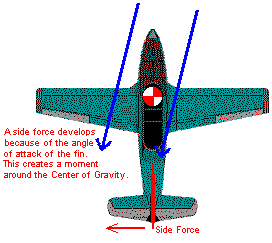
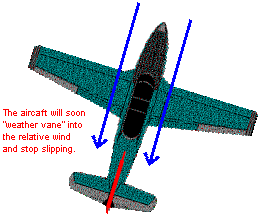
Longitudinal stability depends on the location of the centre of gravity, the stabiliser area and how far the stabiliser is placed from the main wing. Most aircraft would be completely unstable without the horizontal stabiliser. The stabiliser provides the same function in longitudinal stability as the fin does in directional stability.
It is of crucial importance that the aircraft's Centre of Gravity (CG) is located at the right point, so that a stable and controllable flight can be achieved. In order to achieve a good longitudinal stability, the CG should be ahead of the Neutral Point (NP), which is the Aerodynamic Centre of the whole aircraft. NP is the position through which all the net lift increments act for a change in angle of attack. The major contributors are the main wing, stabiliser surfaces and fuselage.
The bigger the stabiliser area in relationship to the wing area and the longer the tail moment arm relative to the wing chord, the farther aft the NP will be and the farther aft the CG may be, provided it's kept ahead of the NP for stability.
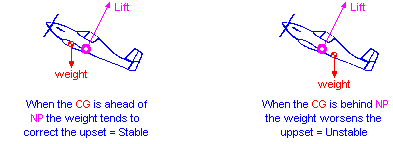
The angle of the fuselage to the direction of flight affects its drag, but has little effect on the pitch trim unless both the projected area of the fuselage and its angle to the direction of flight are quite large.
A tail-heavy aircraft will be more unstable and susceptible to stall at low speed e. g. during the landing approach. A nose-heavy aircraft will be more difficult to takeoff from the ground and to gain altitude and will tend to drop its nose when the throttle is reduced. It also requires higher speed in order to land safely.
The angle between the wing chord line and the stabiliser chord line is called the Longitudinal Dihedral (LD) or decalage. For a given centre of gravity, there is a LD angle that results in a certain trimmed flight speed and pitch attitude. If the LD angle is increased the plane will take on a more nose up pitch attitude, whereas with a decreased LD angle the plane will take on a more nose down pitch attitude.
There is also the Angle of Incidence, which is the angle of a flying surface related to a common reference line drawn along the fuselage. The purpose of this line is to make it easier to set up the relationships among the thrust, the wing and the stabiliser incidence angles. Thus, the Longitudinal Dihedral and the Angle of Incidence are interdependent.
Longitudinal stability is also improved if the stabiliser is situated so that it lies outside the influence of the main wing downwash. Stabilisers are therefore often staggered and mounted at a different height in order to improve their stabilising effectiveness.
It has been found both experimentally and theoretically that, if the aerodynamic force is applied at a location 1/4 from the leading edge of a rectangular wing at subsonic speed, the magnitude of the aerodynamic moment remains nearly constant even when the angle of attack changes. This location is called the wing's Aerodynamic Centre AC. (At supersonic speed, the aerodynamic centre is near 1/2 of the chord).
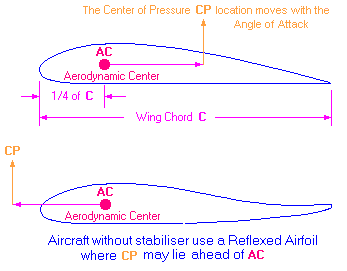
In order to obtain a good Longitudinal Stability the Centre of Gravity CG should be close to the main wings' Aerodynamic Centre AC. For wings with other than rectangular form (such as triangular, trapezoidal, compound, etc.) we have to find the Mean Aerodynamic Chord (MAC) which is the average for the whole wing. See the drawings below:

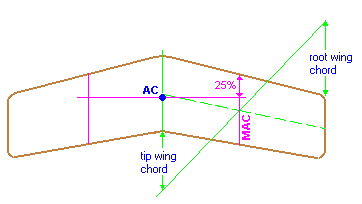
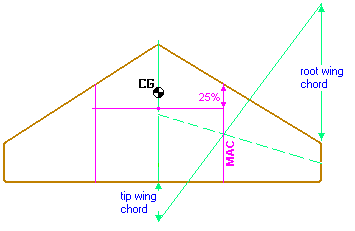
For a delta wing the CG should be located 10% ahead of the geometricaly calculated point as shown above.
For conventional designs (with main wing and horizontal stab) the CG location range is usually between 28% and 33% from the leading edge of the main wing's MAC, which means between about 5% and 15% ahead of the aircraft's Neutral Point NP. This is called the Static Margin, which is expressed as a percentage of MAC. When the static margin is zero (CG coincident with NP) the aircraft is considered "neutrally stable". However, for conventional designs the static margin should be between 5% and 15% of the MAC ahead of the NP.
The CG location as described above is pretty close to the wing's Aerodynamic Center AC because the lift due to the horizontal stab has only a slightly effect on the conventional R/C models.
However, those figures may vary with other designs, as the NP location depends on the size of the main wing vs. the stab size and the distance between the main wing's AC and the stab's AC. The simplest way of locating the aircraft's NP is by using the areas of the two horizontal lifting surfaces (main wing and stab) and locate the NP proportionately along the distance between the main wing's AC point and the stab's AC point. For example, the NP distance to the main wing's AC point is:
D = L · (stab area) / (main wing area + stab area) as shown on the picture below:
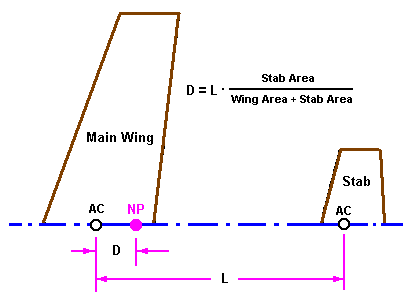
There are other factors, however, that make the simple formula above inaccurate. In case the two wings have different aspect ratios (different dCL/d-alpha) the NP will be closer to the one that has higher aspect ratio. Also, since the stab operates in disturbed air, the NP will be more forward than the simple formula predicts.
The figure below shows a somewhat more complex formula to locate the NP but would give a more accurate result for conventional monoplanes with wings' AR between 4 and 9. This formula gives the NP position as a percentage (%) of the wing's MAC aft of its leading edge.
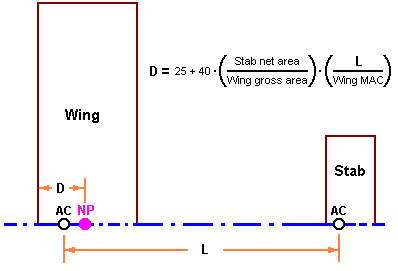
For further equations on how to find the proper CG location with different wing shapes and design configurations including Canards, check here.
